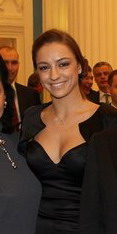|
Eliza Białkowska
Eliza Białkowska (born 19 July 1973) is a retired Polish rhythmic gymnast Rhythmic gymnastics is a sport in which gymnasts perform on a floor with an apparatus: hoop, ball, clubs, ribbon. The sport combines elements of gymnastics, dance and calisthenics; gymnasts must be strong, flexible, agile, dexterous and coordi .... She competed for Poland in the rhythmic gymnastics all-around competition at two Olympic Games: in 1988 in Seoul and in 1992 in Barcelona. In 1988 she was 14th overall, in 1992 15th. References External links at Sports-Reference.com 1973 births Living people Polish rhythmic gymnasts Gymnasts at the 1988 Summer Olympics Gymnasts at the 1992 Summer Olympics Olympic gymnasts for Poland Sportspeople from Lubusz Voivodeship People from Skwierzyna {{Poland-rhythmic-gymnastics-bio-stub ... [...More Info...] [...Related Items...] OR: [Wikipedia] [Google] [Baidu] |
Skwierzyna
Skwierzyna (german: Schwerin an der Warthe) is a town of 9,671 inhabitants (2019) in Lubusz Voivodeship in western Poland, the administrative seat of the Gmina Skwierzyna. It is located at the confluence of the Obra and Warta rivers, about north of Międzyrzecz and south-east of the regional capital Gorzów Wielkopolski. The town is situated in a particularly green part of Poland. Extensive forests and numerous lakes can be found in the vicinity. History Skwierzyna was originally a Slavic fishing settlement, located on an important trade route connecting Szczecin and Kraków. It became part of the emerging Polish state in the 10th century. During the fragmentation period in Polish history, from 1138 it belonged to the Duchy of Greater Poland and from 1296 to 1329 to the Duchy of Głogów. Afterwards it was located in the Poznań Voivodeship within the larger Greater Poland Province. It already held town privileges upon the death of the Piast King Przemysł II of Poland in 129 ... [...More Info...] [...Related Items...] OR: [Wikipedia] [Google] [Baidu] |
Lubusz Voivodeship
Lubusz Voivodeship, or Lubuskie Province ( pl, województwo lubuskie ), is a voivodeship (province) in western Poland. It was created on January 1, 1999, out of the former Gorzów Wielkopolski and Zielona Góra Voivodeships, pursuant to the Polish local government reforms adopted in 1998. The province's name recalls the historic Lubusz Land (''Lebus'' or ''Lubus''), although parts of the voivodeship belong to the historic regions of Silesia, Greater Poland and Lusatia. Until 1945, it mainly formed the Neumark within the Prussian Province of Brandenburg. The functions of regional capital are shared between two cities: Gorzów Wielkopolski and Zielona Góra. Gorzów serves as the seat of the centrally-appointed voivode, or governor, and Zielona Góra is the seat of the elected regional assembly (sejmik) and the executive elected by that assembly, headed by a marshal (''marszałek''). In addition, the voivodeship includes a third city (Nowa Sól) and a number of towns. The reg ... [...More Info...] [...Related Items...] OR: [Wikipedia] [Google] [Baidu] |
Poland
Poland, officially the Republic of Poland, is a country in Central Europe. It is divided into 16 administrative provinces called voivodeships, covering an area of . Poland has a population of over 38 million and is the fifth-most populous member state of the European Union. Warsaw is the nation's capital and largest metropolis. Other major cities include Kraków, Wrocław, Łódź, Poznań, Gdańsk, and Szczecin. Poland has a temperate transitional climate and its territory traverses the Central European Plain, extending from Baltic Sea in the north to Sudeten and Carpathian Mountains in the south. The longest Polish river is the Vistula, and Poland's highest point is Mount Rysy, situated in the Tatra mountain range of the Carpathians. The country is bordered by Lithuania and Russia to the northeast, Belarus and Ukraine to the east, Slovakia and the Czech Republic to the south, and Germany to the west. It also shares maritime boundaries with Denmark and Sweden. ... [...More Info...] [...Related Items...] OR: [Wikipedia] [Google] [Baidu] |
Rhythmic Gymnastics
Rhythmic gymnastics is a sport in which gymnasts perform on a floor with an apparatus: hoop, ball, clubs, ribbon. The sport combines elements of gymnastics, dance and calisthenics; gymnasts must be strong, flexible, agile, dexterous and coordinated. Rhythmic gymnastics is governed by the International Gymnastics Federation (FIG), which first recognized it as a sport in 1963. It became an Olympic sport in 1984, with an individual all-around event. The group all-around competition was added to the Olympics in 1996. At the international level, rhythmic gymnastics is a women-only sport. The most prestigious competitions, besides the Olympic Games, are the World Championships, World Games, European Championships, European Games, the World Cup Series and the Grand Prix Series. Gymnasts are judged on their artistry, execution of skills, and difficulty of skills, for which they gain points. They perform leaps, balances, and rotations along with handling the apparatus. History Rhythm ... [...More Info...] [...Related Items...] OR: [Wikipedia] [Google] [Baidu] |
Rhythmic Gymnast
Rhythmic gymnastics is a sport in which gymnasts perform on a floor with an apparatus: hoop, ball, clubs, ribbon. The sport combines elements of gymnastics, dance and calisthenics; gymnasts must be strong, flexible, agile, dexterous and coordinated. Rhythmic gymnastics is governed by the International Gymnastics Federation (FIG), which first recognized it as a sport in 1963. It became an Olympic sport in 1984, with an individual all-around event. The group all-around competition was added to the Olympics in 1996. At the international level, rhythmic gymnastics is a women-only sport. The most prestigious competitions, besides the Olympic Games, are the World Championships, World Games, European Championships, European Games, the World Cup Series and the Grand Prix Series. Gymnasts are judged on their artistry, execution of skills, and difficulty of skills, for which they gain points. They perform leaps, balances, and rotations along with handling the apparatus. History Rhythmi ... [...More Info...] [...Related Items...] OR: [Wikipedia] [Google] [Baidu] |
Gymnastics At The 1988 Summer Olympics – Women's Rhythmic Individual All-around
These are the results of the rhythmic individual all-around competition, the only Rhythmic Gymnastic event at the 1988 Summer Olympics. Rules for the rhythmic gymnastics competition had changed after the previous Olympics. The ball apparatus was replaced by the rope. Thirty-nine gymnasts competed in the preliminary round, Each gymnast completed one exercise with each apparatus, and the twenty best gymnasts advanced to the finals. Each competitor carried over half her preliminary round score (prelim score) to the final, where it was added to her score in the final (final score). In the final, they again performed one exercise with each apparatus. Each of the routines were judged by six judges, highest and lowest marks were dropped, and the average of the four remaining marks was the gymnast's score for the routine. Preliminary round Final References External links * https://web.archive.org/web/20160811083328/http://www.gymnasticsresults.com/80/o1988rh.html Women's ... [...More Info...] [...Related Items...] OR: [Wikipedia] [Google] [Baidu] |
Gymnastics At The 1992 Summer Olympics – Women's Rhythmic Individual All-around
These are the results of the rhythmic individual all-around competition, the only Rhythmic Gymnastic event at the gymnastics at the 1992 Summer Olympics, 1992 Summer Olympics. The four pieces of apparatus used were ball (rhythmic gymnastics), ball, clubs (rhythmic gymnastics), clubs, hoop (rhythmic gymnastics), hoop, and rope (rhythmic gymnastics), rope (ribbon (rhythmic gymnastics), ribbon was omitted). 42 gymnasts competed in the preliminary round. The format for the competition was unusual. Instead of choosing the gymnasts with the highest scores from the qualifying round to advance to the final (as had been the case in 1984 and 1988), it was decided that the six best would qualify for the final, along with the top 12 for each apparatus, meaning that nine of the 17 finalists performed in the final with only one to three pieces of apparatus and had no chance to win. Each gymnast carried forward half her preliminary round score (prelim score) to the final, where it was added ... [...More Info...] [...Related Items...] OR: [Wikipedia] [Google] [Baidu] |
1973 Births
Events January * January 1 - The United Kingdom, the Republic of Ireland and Denmark 1973 enlargement of the European Communities, enter the European Economic Community, which later becomes the European Union. * January 15 – Vietnam War: Citing progress in peace negotiations, U.S. President Richard Nixon announces the suspension of offensive action in North Vietnam. * January 17 – Ferdinand Marcos becomes President for Life of the Philippines. * January 20 – Richard Nixon is Second inauguration of Richard Nixon, sworn in for a second term as President of the United States. Nixon is the only person to have been sworn in twice as President (First inauguration of Richard Nixon, 1969, Second inauguration of Richard Nixon, 1973) and Vice President of the United States (First inauguration of Dwight D. Eisenhower, 1953, Second inauguration of Dwight D. Eisenhower, 1957). * January 22 ** George Foreman defeats Joe Frazier to win the heavyweight world boxing championship. ** A ... [...More Info...] [...Related Items...] OR: [Wikipedia] [Google] [Baidu] |
Living People
Related categories * :Year of birth missing (living people) / :Year of birth unknown * :Date of birth missing (living people) / :Date of birth unknown * :Place of birth missing (living people) / :Place of birth unknown * :Year of death missing / :Year of death unknown * :Date of death missing / :Date of death unknown * :Place of death missing / :Place of death unknown * :Missing middle or first names See also * :Dead people * :Template:L, which generates this category or death years, and birth year and sort keys. : {{DEFAULTSORT:Living people 21st-century people People by status ... [...More Info...] [...Related Items...] OR: [Wikipedia] [Google] [Baidu] |
Polish Rhythmic Gymnasts
Polish may refer to: * Anything from or related to Poland, a country in Europe * Polish language * Poles, people from Poland or of Polish descent * Polish chicken *Polish brothers (Mark Polish and Michael Polish, born 1970), American twin screenwriters Polish may refer to: * Polishing, the process of creating a smooth and shiny surface by rubbing or chemical action ** French polishing, polishing wood to a high gloss finish * Nail polish * Shoe polish * Polish (screenwriting), improving a script in smaller ways than in a rewrite See also * * * Polonaise (other) A polonaise ()) is a stately dance of Polish origin or a piece of music for this dance. Polonaise may also refer to: * Polonaises (Chopin), compositions by Frédéric Chopin ** Polonaise in A-flat major, Op. 53 (french: Polonaise héroïque, lin ... {{Disambiguation, surname Language and nationality disambiguation pages ... [...More Info...] [...Related Items...] OR: [Wikipedia] [Google] [Baidu] |
Gymnasts At The 1988 Summer Olympics
Gymnastics is a type of sport that includes physical exercises requiring balance, strength, flexibility, agility, coordination, dedication and endurance. The movements involved in gymnastics contribute to the development of the arms, legs, shoulders, back, chest, and abdominal muscle groups. Gymnastics evolved from exercises used by the ancient Greeks that included skills for mounting and dismounting a horse, and from circus performance skills. The most common form of competitive gymnastics is artistic gymnastics (AG), which consists of, for women (WAG), the events floor, vault, uneven bars, and beam; and for men (MAG), the events floor, vault, rings, pommel horse, parallel bars, and horizontal bar. The governing body for gymnastics throughout the world is the Fédération Internationale de Gymnastique (FIG). Eight sports are governed by the FIG, which include gymnastics for all, men's and women's artistic gymnastics, rhythmic gymnastics, trampolining (including double mini-tra ... [...More Info...] [...Related Items...] OR: [Wikipedia] [Google] [Baidu] |




